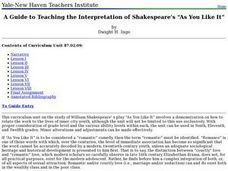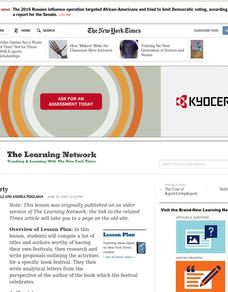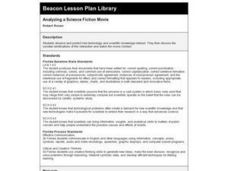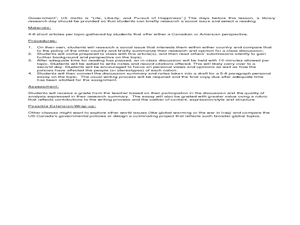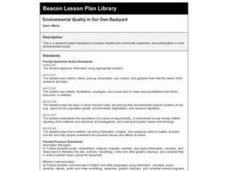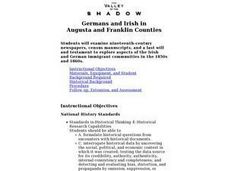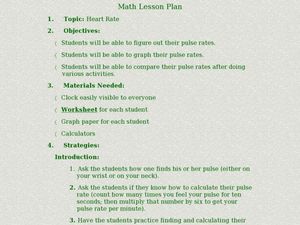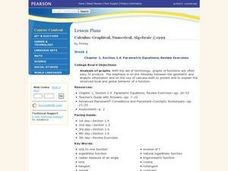Curated OER
Heart of Darkness
Students interpret the resolution of Joseph Conrad's Heart of Darkness. In this literature lesson, students discuss the ending of the novella and Conrad's intentions in ending it the way he did. Students then write alternative endings...
Curated OER
Interpretation of Shakespeare's "As You Like It"
Students are introduced to the background behind Shakespeare's "As You Like It". In groups, they compare and contrast the family issues in the play with those in their own family. They also write the traits of each character and answer...
Curated OER
Show Me a Flowerpot
Students compare and contrast handmade and machine-made products in a study about the evolution of production processes in American history. In this production history instructional activity, students explore a flowerpot in depth....
Curated OER
Book Party
Pupils compile a list of titles and authors worthy of having their own festivals, then research and write proposals outlining the activities for a specific book festival. They write analytical letters from the perspective of the author...
Curated OER
Risk Assessment and Geometry
Tenth graders study the concept of risk analysis as it relates to geometry. For this spatial relationship lesson, 10th graders are provided a set of coordinates to analyze a piece of land described. Students write a description that...
Curated OER
Analyzing a Science Fiction Movie
Fourth graders watch the movie "Contact" and write a review. They discuss in their review how scientists deal with technological problems, the movie's connections to the nature of science and how technology affects science. They share...
Curated OER
Investigating History with Kidd Gloves
Students act as historical archeologists and use their analytical skills to deduce, from lists of items related to historic figures, accurate details about the lives of those people.
Curated OER
Abolitionists in U.S. History
Young scholars read and discuss excerpts from the writings of Henry David Thoreau, Frederick Douglass and Sarah Parker Redmond. They compare and contrast the views of the three abolitionists concentrating on the experiences and reasons...
Curated OER
Death in Poetry: A.E. Housman's "To an Athlete Dying Young" and Dylan Thomas' "Do Not Go Gentle into That Good Night"
Students analyze poems about death. In this poetry analysis lesson, students read poems from both Dylan Thomas and A.E. Housman and analyze them in groups for common poetic devices. Students present their analysis and complete a Venn...
Curated OER
A Look at U.S. and Canadian Approaches to Individual Liberties
Students compare and contrast Canadian and U.S. policies regarding social issues. In this sociology instructional activity, students research social and governance policies in the countries and write personal essays using their findings.
Curated OER
Environmental Quality in Our Own Backyard
Students research an environmental issue and decide on a course of action. They write a reseach paper and present an oral presentation based on the research.
Curated OER
Germans and Irish in Augusta and Franklin Counties
Students examine 19th century newspapers, a last and testament, and census manuscripts to analyze the Irish and German immigrant communities in the 1850s and 1860s. They write a letter from the perspective of an Irish or German immigrant.
DocsTeach
Examining Where Rosa Parks Sat
When Rosa Parks took her seat on a public bus to protest segregation, she also took her place in history. Learners examine a clue from this story—a diagram of the bus—to see if they can figure out the pivotal role of this...
Curated OER
American Political Thought: Minority Influence
Sixth graders brainstorm the reasons why people would want to leave their homeland to live in the United States. In groups, they research the political representation of the Board in New Haven, Connecticut. They also write a paper on...
Curated OER
Graphing Heart Rates
Young scholars explore heart rates. They record pulse rates, predict which exercises cause a faster heart rate, make a chart, and graph the results. Students write an essay using the data to support their predictions. They write a...
Curated OER
Art or Artifact?
High schoolers analyze and discuss illustrations of the New World by John White. They examine the images, answer questions about each one, and write an essay.
Curated OER
Science Habits of Mind
Students study good communication skills. In this communication lesson students write step by step instructions for a procedure.
Curated OER
The Great Scientific Debate
Fourth graders examine scientific issues that affect the public by debating their classmates. They also write brief essays that show they have learned how to express their reasons for their pros and cons of a particular topic.
Curated OER
"how To Think Like an Archaeologist" Suggested Pre-visit Activity for Historic Jamestowne
Students study grocery receipts to simulate the archaeological activity of classifying items. They discuss the receipts as if they were find lists.
Curated OER
How To Think Like An Archaeologist
High schoolers take a field trip to historical Jamestown. Using artifacts given to them, they must identify them and discover who would have used them and for what purpose. They create a database to organize the information and share...
Curated OER
Calculus: Graphical, Numerical, Algebraic
Students explore the interplay between the geometric and analytic information and on the use of calculus both to predict and to explain the observed local and global behavior of a function. They write a paragraph describing any...
Curated OER
Lewis and Clark Encounters with Native Americans
Students research what the exchange was between the various Native American groups and Lewis and Clark. They are able to write reflections after truly considering the issue with the help of research.
Curated OER
Which Bird Is Different?
In this visual discrimination instructional activity, students study 5 rows of similar bird pictures. In each row, students circle that picture that is different.
Curated OER
Interpreting Photographs
Students examine photographs and complete research on river transportation. They describe the beginnings and innovations of the steamboats. Students research the development of trade from the 1700s through the 1800s. They write a...



